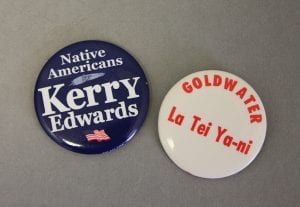On July 15th, 1948, Native American suffrage was finally passed with the Arizona Supreme Court overturning the case of Porter v. Hall, a case where Arizona Native Americans unsuccessfully sued for the right to vote. This gave the Indigenous population of Arizona the right to vote. This historic day came into fruition after decades of battles to ensure this constitutional right. Even after the much awaited law was passed, Native Americans have confronted many issues, from voter suppression to racial discrimination. Today we celebrate the victories of suffrage while examining the continued challenges Native Americans face at the polls today.
From Manifest Destiny to Jim Crow
Manifest Destiny, an ideology that Westward Expansion was not only inevitable but also justifiable, brought many Anglo-American settlers to the Arizona Territory. During the 1870s, exclusionary laws were set in place to disenfranchise non-white voters, in direct violation of the 15th Amendment. . The United States government did not recognize Native American peoples as U.S. citizens, as they were only considered citizens of their sovereign tribe. The U.S. government made several arguments to restrict the Native American vote. They argued that Native American peoples could not be considered U.S. citizens because they lived on Indian Reservations and therefore did not reside in the state. The economy was another tactic that was used to discredit the vote. Since peoples living on the reservation were not required to pay state taxes, the government argued that Native American voices could not be included in economic decision making. Many actions and legal cases were fought to allow voting for Indigenous people.
In 1924, a major victory was won with the passage of the Indian Citizenship Act. Native Americans were now considered United States citizens. However, this new law did not ensure the right to vote. In 1928, Peter Porter and Rudolph Johnson of the Gila River Indian Community attempted to register to vote in Pinal County. With the presidential election being held that year, Porter and Johnson were eager to cast their vote. They were denied by the Pinal County recorder for two reasons: first, the recorder stated that they were not subject to the law of the state because of their residence on the reservation. Second, was a belief that they were “under guardianship, non compos mentis, or insane”. Seeking justice, Porter and Johnson fought this decision by filing a lawsuit in the case Porter v. Hall. Their case was overturned.
The Nationality Act of 1940 passed by Congress reaffirmed citizenship to Native Americans. After this Act was passed, 10% of Native Americans enlisted to fight in World War II. Upon returning from the war, Indigenous veterans were still not afforded the freedom to vote. The argument that Native Americans could not vote because they lived and were employed on the reservation was no longer valid. In 1948, the state Supreme Court overturned the results of Porter v. Hall. This finally passed Native American suffrage in Arizona.
Obstacles After Suffrage
Even after the right to vote was won, Arizona’s Native American population were still denied access to the polls for two more decades. English literacy tests were issued to would-be voters; they were required to read the United States Constitution in English and write their own names. Schools for Native American Arizonans were not sufficiently educating the youth, leading to illiteracy rates as high as eighty to ninety percent. The Voting Rights Act was passed by Congress in 1965 and allowed all Americans the accessibility to vote. The VRA reinforced voting rights for Native Americans in Arizona. The passage of this Act prohibited the discrimination of non-English speaking Americans, a major challenge that many Native Americans faced. This, however, did not eradicate many of the discriminatory tactics used to suppress votes. Literacy tests deterred non-English speaking Native Americans from voting in elections. These exclusionary practices were continued until the 1970s when literacy tests were outlawed.
Current Challenges and Voter Suppression
Even with victory in securing the right to vote on Indian Country, there are still barriers that many Native Americans face today. One of the biggest modern problems is access to polls. Many reservations in Arizona span hundreds of miles, are oftentimes rural, and have limited polling stations that can be miles apart. This poses a problem to individuals that do not have access to a car. According to Arizona’s census data, about 1 in 5 people living on a reservation do not have access to a vehicle. These limitations can be problematic.
Even a mail-in ballot solution is still not sufficient. Due to the rural nature of Arizona reservations, many people do not have physical home addresses and use P.O. boxes. In Arizona, only 18 percent of reservation residents outside of Maricopa and Pima Counties have physical addresses that receive mail. This also poses a problem to individuals that are not permanent residents. According to the Department of Housing and Urban Development, between 42,000 and 85,000 people living on a reservation do not have a permanent address and move from house to house. Ballots in Arizona are also not translated to any Indigenous languages to accommodate Americans that do not speak English as a primary language. Many areas on the reservation do not have access to the internet, or even electricity. This fact does not get addressed when laws are put into place.
Since the Constitution granted the right to vote to Native Americans, over 100 lawsuits have been filed to combat unjust voter suppression in Indian Country. Today the fight for Native American voices is still ongoing. As we celebrate past civil rights victories, we can still look at the current injustices going in Arizona and fight for a better future.
Read More
The History of Indian Voting Rights in Arizona: Overcoming Decades of Voter Suppression by Patty Ferguson-Bohnee
You Gotta Fight for the Right to Vote: Enfranchising Native American Voters by Jeanette Wolfley
Rising Arizona: The Legacy of the Jim Crow Southwest on Immigration Law and Policy After 100 Years of Statehood by Kristina M. Campbell
Photos from the AHS Collections
Navajo voters cast their ballots in the 1955 Tribal Election. Arizona Historical Society, Tucson, MS 1255, Box 27, fol. 402, Photo #AC
Campaign buttons showing Native American involvement in U.S. politics. Arizona Historical Society, Tempe P2008.4.4 and P89.1.71





